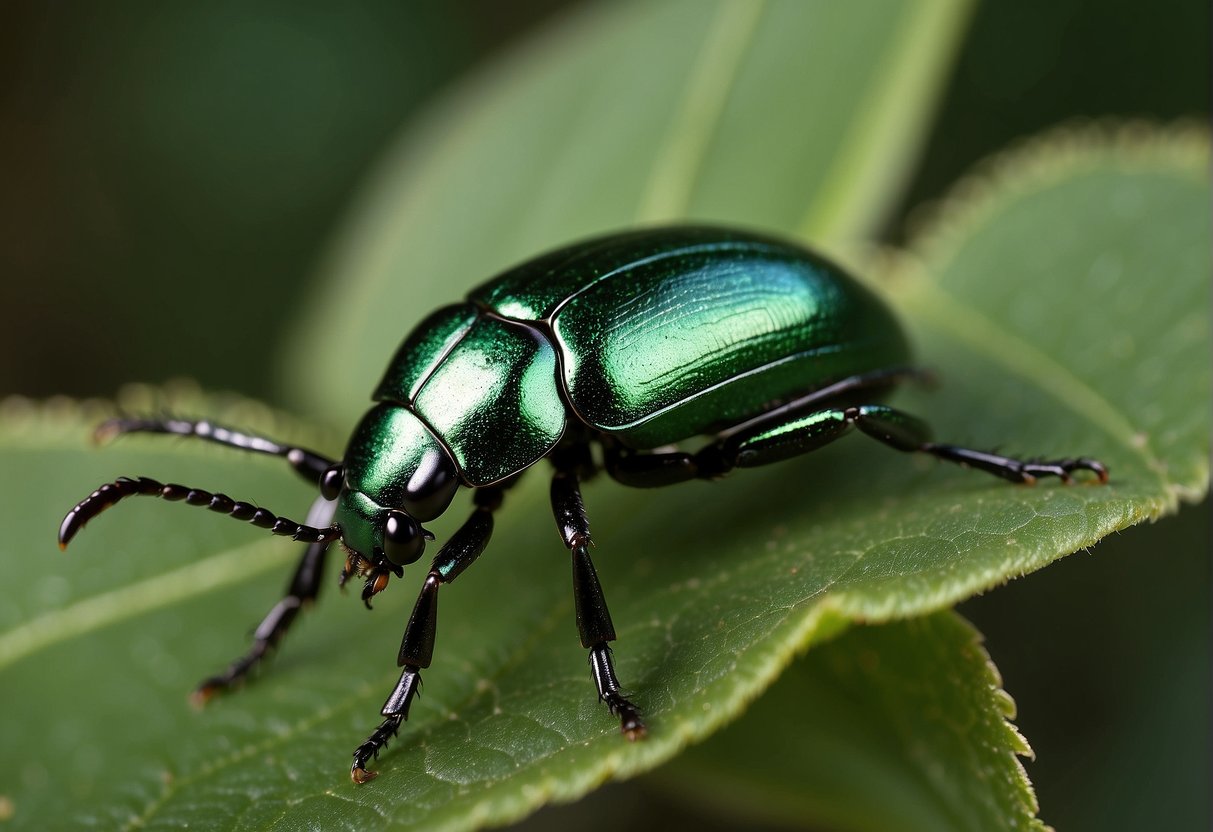I’ve studied flea beetles thoroughly and can describe them quite precisely. These tiny pests are known for their distinct ability to leap, similar to how fleas move—hence their name. Flea beetles belong to various species, with a size range typically between 1/16 to 1/8 inch long; some outliers like the spinach flea beetle, however, grow as large as 1/4 inch.

Identifying flea beetles involves looking for small, shiny insects that may be black, bronze, blue, or a mix of other colors. Patterns vary, with some displaying stripes on their hard shell.
They are notorious pests in gardens, as they cause damage characterized by small holes or “shotholes” in the foliage of plants like tomatoes, eggplants, and leafy greens. As an enthusiast in plant and insect interactions, I pay attention to these signs when identifying an infestation.
Flea beetles can be challenging to spot due to their small size and quick movements. However, my experience has led me to understand that one can often identify their presence by the damage they leave behind before actually spotting the beetle itself. You may notice the young, tender leaves of your plants riddled with holes or a lace-like appearance, which is a telltale sign of flea beetles’ voracious feeding habits.
JUMP TO TOPIC
Identifying Flea Beetles
I understand the frustration gardeners feel when they see their plants damaged, so recognizing the culprit is key. Here, I’ll guide you on how to identify flea beetles, including their various types and life cycle considerations.
Appearance and Types
Characterizing flea beetles by their appearance involves noting their small size and ability to jump. I’ve observed that these beetles often have shiny round bodies that can be black, tan, bronze, or even bluish, sometimes with contrasting stripes or spots. Based on the nibbles in my garden, I’ve categorized some common species:
- Potato Flea Beetle: Predominantly black, specializes in targeting potato plants.
- Striped Flea Beetle: Features distinct stripes on its wings with either a shiny black or greenish carapace.
- Western Black Flea Beetle: Has a dark green to black appearance and is commonly found in western regions.
- Eggplant Flea Beetle: Mostly black, these beetles favor eggplants.
Life Cycle and Overwintering
Flea beetles go through a complete metamorphosis in their life cycle. From my findings, they start as eggs laid in the soil. The larvae that emerge feed on root systems, then develop into the adult beetles you see leaping about plants. Here’s what I’ve noted about their overwintering behavior:
- Adult flea beetles typically overwinter in soil or plant debris.
- Understanding their habitat preferences can provide insights into effective control methods.
Throughout the seasonal shifts, I actively monitor my garden for signs of flea beetles, keeping in mind their life cycle to preemptively deter the next generation.
Damage Caused by Flea Beetles
Flea beetles are notorious for their ability to cause significant harm to a wide variety of vegetable crops, particularly at the seedling stage. Their presence is most commonly recognized by the damage they inflict on foliage, which can be severe enough to reduce plant vigor and yield.
Recognizing Beetle Damage
I know beetle damage on sight—irregular holes and chewed edges in leaves are telltale signs. This marred condition, often referred to as “shotholes,” looks as if the foliage has been peppered with buckshot.
When inspecting plants, I look for:
- Short, narrow, and serpentine tracks: indicative of larval feeding, happening near or on the roots.
- Irregular holes on leaves: adults chomp through the leaf tissue, not touching the veins, causing shotholed appearance.
- Mottled yellowing and browning: when damage intensifies, it may lead to widespread discoloration.
Plants Affected
Over the years, I’ve observed flea beetles attacking a range of plants, with certain types being more susceptible:
Vegetable Crops Commonly Affected by Flea Beetles:
- Eggplant: They especially favor eggplants, inflicting enough damage to stunt growth or kill young plants.
- Cabbage and Broccoli: Cole crops like these often face beetle infestations.
- Radishes: Both the leaves and the developing tubers get marked and scarred.
- Leafy Greens: Lettuce and spinach can become riddled with holes, drastically lowering market value.
- Nightshades: Tomatoes, peppers, and potatoes can suffer foliage loss, impacting photosynthesis and growth.
I’m careful to alert fellow gardeners that flea beetle damage not only affects plant aesthetics and growth but can also act as a vector for diseases like wilt and blight, compounding the issue. As such, recognizing and addressing flea beetle damage quickly is critical to protect vulnerable crops, especially during their tender seedling stages when they can least afford to lose foliage.
Prevention and Control
In my experience with gardening, I’ve found that prevention and control of flea beetles are crucial for protecting plants. It involves both cultural practices and targeted biological and chemical solutions.
Cultural Practices
💥 Key strategies include:
- Trap crops: Planting sacrificial plants like mustard or radish can lure beetles away from main crops.
- Floating row covers: Installing these covers protects plants during peak beetle activity.
- Weed management: I always remove weeds and leaf litter to destroy beetle habitats.
- Tilling: Turning the soil exposes flea beetle larvae to predators and the elements.
Biological and Chemical Solutions
While I prefer non-chemical methods, sometimes biological or chemical controls are necessary to manage flea beetle infestations effectively.
💥 I use these solutions judiciously:
- Beneficial insects: I release predators like braconid wasps and tachinid flies, which prey on flea beetles.
- Neem oil and insecticidal soap: Both offer organic control when sprayed directly on the beetles or plants.
- Chemical pesticides: If necessary, I use targeted chemicals like spinosad for severe infestations.
- Beauvaria bassiana: This fungus acts as a biological insecticide to control flea beetle populations.
Always follow label directions and safety precautions when using pesticides, even organic ones.












